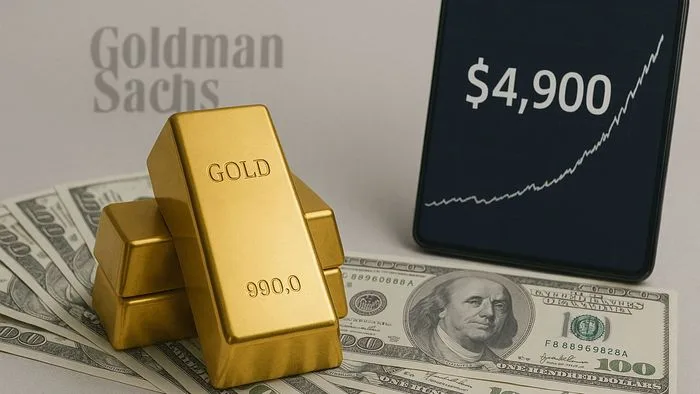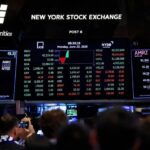By Tom Ozimek
Goldman Sachs raised its December 2026 gold price forecast by $600 to $4,900 per ounce, citing surging exchange-traded fund (ETF) inflows in Western markets and sustained accumulation of the yellow metal by central banks.
The investment bank’s latest gold price prediction, made in an Oct. 7 client note, marks a significant upgrade to its prior forecast, which called for a rally to $4,300 by the end of next year. What’s more, Goldman said it sees risks to this upgraded estimate as “skewed to the upside,” given the potential for “private sector diversification into the relatively small gold market,” which could push ETF holdings even higher than its model currently implies.
The upward revision comes as gold futures breached $4,000 per ounce for the first time this week, extending a historic rally that has seen prices double in less than two years amid widespread economic and geopolitical turbulence.
Gold futures on COMEX reached a record intraday high of $4,014.60 on Oct. 7, before settling just below that mark. Spot gold also briefly topped $4,000, boosted by safe-haven demand as the U.S. government shutdown entered its second week.
‘Perfect Storm’ of Macro Forces
Goldman analysts said in the note that they expect central banks to continue adding to their reserves, projecting purchases to average 80 metric tons in 2025 and 70 tons in 2026, largely from emerging market institutions diversifying away from the U.S. dollar.
The investment bank also expects Western ETF demand to strengthen as the Federal Reserve lowers rates by a full percentage point by mid-2026, a move it says could lift gold prices by about five percent.
These trends tie into what some analysts are calling a “perfect storm” of macroeconomic drivers—including inflation fears, currency weakness, and policy uncertainty—converging in gold’s favor.
“There are several macro factors driving gold’s outperformance this year,” Nic Puckrin, investment analyst and co-founder of The Coin Bureau, told The Epoch Times in an emailed statement. “Firstly, it’s an ongoing U.S. dollar debasement trade. We have massive fiscal spending in the U.S. with the Big Beautiful Bill and loosening monetary policy, which is fuelling renewed concerns over inflation.”
Puckrin noted that similar inflationary forces are emerging outside the United States, pointing to Japan’s revival of stimulus-style policies as another driver of demand for hard assets. In such an environment, he said, investors are naturally gravitating toward gold as a time-tested hedge against inflation. Central banks are also steadily adding to their reserves to reduce reliance on the U.S. dollar—a convergence of factors Puckrin described as a “perfect storm” likely to keep supporting prices in line with Goldman’s outlook.
The latest leg of the rally has also been underpinned by rapid inflows into gold-backed ETFs. Data from ING show global ETF holdings have risen for nine straight sessions, reaching 97.4 million ounces—their highest level since September 2022.
Fiat Fears and Portfolio Rebalancing
According to Stefan Gleason, CEO of Money Metals Exchange, gold’s surge past $4,000 reinforces its role as a “hedge against accelerating fiat destruction and fiscal instability.” The metal is up more than 50 percent this year, Gleason said, driven in part by currency debasement, geopolitical tension, and central bank buying, as well as by “a rebalancing on Wall Street” where investors are increasingly holding gold in lieu of U.S. Treasuries.
“This precious metals rally has accelerated with the Federal Reserve’s renewed rate cuts, which have driven real yields lower,” he told The Epoch Times in an emailed statement. “Just as importantly, we are seeing a rebalancing on Wall Street with investment houses like Morgan Stanley recently recommending a partial swap of bonds for gold.”
Two weeks ago, Morgan Stanley’s investment manager urged investors to move from a traditional 60/40 stock-to-bond split to 60/20/20—adding gold as a core 20 percent holding. “Goldman’s $4,900 call is absolutely realistic, if not conservative,” Gleason said. “Most investors in the U.S. still have almost no allocation to gold, and that means this shift from bonds to gold may just be getting started.”
This evolving investor behavior could amplify the metal’s gains well beyond base-case forecasts, Goldman said in a previous report. In it, the bank estimated that if just 1 percent of the $24 trillion U.S. Treasury market were reallocated into gold, prices could approach $5,000 an ounce—even without broader financial upheaval. With Wall Street now openly debating portfolio shifts of that kind, Goldman’s once-theoretical scenario appears increasingly plausible.
Veteran trader Vince Stanzione, CEO of First Information, said that a growing loss of investor confidence in the U.S. dollar is a key driver of the gold surge.
“The recent rally, which really started in 2022 after the U.S. blocked Russian funds, is down to loss of faith in the dollar,” he told The Epoch Times in an emailed statement. “Gold is a tier-one asset, which means banks can hold it at full value.”
He said retail investors have yet to fully catch on to the implications of falling purchasing power of the greenback. “I have been calling for gold at $7,000 by 2028 for some years,“ he said. ”However, I think I need to increase that. Remember, we are pricing in a debasing currency.”
Reuters contributed to this report.





